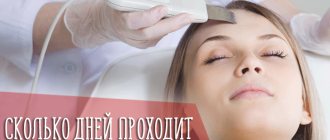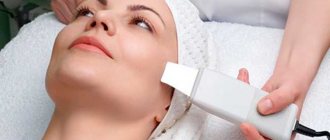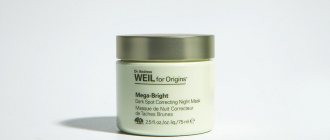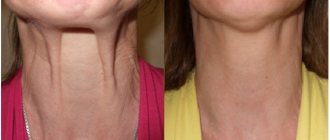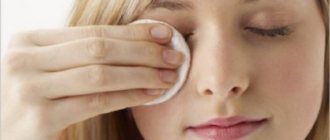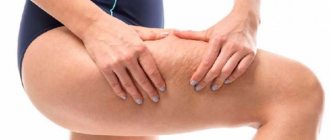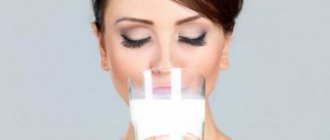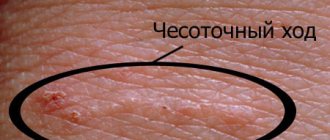The most long-awaited and enjoyable time in a woman’s life is pregnancy. And often during this period all sorts of unpleasant surprises appear. Pregnancy is accompanied by emotional outbursts, changes in a woman’s entire body, old diseases may worsen or new ones may appear. Among the unpleasant surprises are red spots on the face that peel off.
In humans, skin color is affected by the concentration of melanin. It is found in melanosomes, which help protect the top layer of skin from ultraviolet rays. When pregnancy occurs, the body is completely rebuilt, hormonal changes occur, and the amount of melanin also changes. It is produced in volumes greater than normal, and therefore is located on different parts of the body and face. That's why red spots appear on the face.
Red spots on the face may appear if a woman took oral contraceptives before pregnancy. Epilepsy medications can have the same effect. Red spots on the face may indicate a lack of folic acid in the body.
There are other causes of pigmentation. Among them are hereditary factors, pathologies in the liver, ovaries, and low-quality cosmetics.
Under the influence of ultraviolet radiation, pigmentation only intensifies, so it is advisable for women to spend less time in the sun during pregnancy. This problem begins to disappear around two months after the baby is born. But there may also be cases when the spots do not disappear for several years. Which happens rarely.
If this problem causes discomfort and discomfort, you can seek help from a cosmetologist or dermatologist. In cases where this is a consequence of an allergy to cold or sun, the following symptoms appear:
- red spots on the face are peeling;
- the skin becomes rougher and rougher;
- redness intensifies under the influence of provoking factors;
- spots may itch and tighten the skin;
- characteristic places of occurrence are the chin, cheeks, and nose.
Types of examination for spots on the face:
- visiting a number of doctors: dermatologist, endocrinologist, neurologist, gastroenterologist;
- blood tests;
- immunogram;
- allergen tests;
- scraping the stain;
- if there is a suspicion of diseases of the internal organs: ultrasound, colonoscopy, gastroscopy and others.
Speaking from a medical point of view, getting rid of pigmentation during pregnancy is not advisable. Because this is an absolutely normal phenomenon. And there is no harm to either the mother’s body or the fetus. The best option is to wait until the spots go away on their own.
But not everyone can wait; many feel discomfort, which causes complexes to appear. There are several ways to remove stains. And they will not harm the baby in the womb.
A variety of lotions and masks offered by traditional medicine have a good effect. You can use different products and wipe the stains. They help a lot:
- parsley juice, which has a whitening effect;
- cranberry juice;
- red currant;
- raspberries;
- strawberries;
- Luke;
- sweet pepper.
The swab should be soaked in juice, wipe the stains and not rinse off. You can do this a couple of times during the day.
Sour cream and milk are mixed in equal parts, a gauze swab is soaked in this mixture and applied to the face. Leave on for 20 minutes and rinse off.
Lemon juice is mixed with honey (2 tablespoons), a gauze swab should be soaked in this solution and left on the face for half an hour.
Gauze can be soaked in yogurt. You can cook it yourself or buy it at the store.
Red spots can be wiped with kefir, left for fifteen minutes, and then applied parsley juice.
Cucumber gruel will help. Keep on your face for about 20 minutes and rinse with lukewarm water. The same mask can be made using parsley.
It is enough to apply lotions before going to bed. It is advisable to use these folk remedies if you are not allergic to any component of the mask; you must be careful.
Cosmetics can also help hide this problem on the face during pregnancy. The main thing is that they are natural, since everything that the mother’s skin absorbs will get to the baby.
If you follow certain rules during pregnancy, you can prevent the appearance of spots. It is undesirable to be in the sun from twelve to six o'clock in the evening. And before going outside, you should apply a high-protection sun cream.
Use only natural cosmetics. If your doctor recommends taking vitamins, do not ignore this advice. Eat healthy and balanced. It is very important not to forget that, most likely, the red spots will go away on their own after childbirth, so there is no need to worry.
Sometimes a woman develops red spots on her face that are similar to pigment spots. Most often it is an allergy to something. Therefore, you should consult a doctor and, if necessary, be examined. If the stimulus is excluded, they will disappear. Allergies during pregnancy should not frighten or surprise, as different processes occur in the body.
Pregnancy is accompanied by changes throughout a woman’s body; old diseases may worsen or new ones may appear. Among the unpleasant surprises are red spots on the face that peel off.
The most long-awaited and enjoyable time in a woman’s life is pregnancy. And often during this period all sorts of unpleasant surprises appear. Pregnancy is accompanied by emotional outbursts, changes in a woman’s entire body, old diseases may worsen or new ones may appear. Among the unpleasant surprises are red spots on the face that peel off.
This cosmetic defect has many causes. Red spots can form for the following reasons:
In humans, skin color is affected by the concentration of melanin. It is found in melanosomes, which help protect the top layer of skin from ultraviolet rays. When pregnancy occurs, the body is completely rebuilt, hormonal changes occur, and the amount of melanin also changes. It is produced in volumes greater than normal, and therefore is located on different parts of the body and face. That's why red spots appear on the face.
Red spots on the face may appear if a woman took oral contraceptives before pregnancy. Epilepsy medications can have the same effect. Red spots on the face may indicate a lack of folic acid in the body.
There are other causes of pigmentation. Among them are hereditary factors, pathologies in the liver, ovaries, and low-quality cosmetics.
Under the influence of ultraviolet radiation, pigmentation only intensifies, so it is advisable for women to spend less time in the sun during pregnancy. This problem begins to disappear around two months after the baby is born. But there may also be cases when the spots do not disappear for several years. Which happens rarely.
If this problem causes discomfort and discomfort, you can seek help from a cosmetologist or dermatologist. In cases where this is a consequence of allergies to cold or sun, the following symptoms appear:
- red spots on the face are peeling;
- the skin becomes rougher and rougher;
- redness intensifies under the influence of provoking factors;
- spots may itch and tighten the skin;
- characteristic places of occurrence are the chin, cheeks, and nose.
Pregnancy and headache... Why?
Triggers that cause cephalalgia and migraines during pregnancy:
1. Lack of sleep.
2. Low blood sugar.
3. Dehydration.
4. Elimination of caffeine (if you are used to it).
5. Stress.
A migraine is a little different from a regular headache. In contrast, migraines are characterized by throbbing pain, usually on the sides - in the temples (during pregnancy, migraines often occur for the first time - about 16%). Paradoxically, many women who constantly suffered from migraines before pregnancy feel relief during this period. Others have the same problems as before. If you are pregnant and notice signs of migraine, consult your doctor as soon as possible, who will recommend appropriate medications and therapeutic methods.
Migraines typically occur in the third trimester and are usually associated with poor posture (rapid weight gain increases stress on the back, and low back problems are more or less associated with migraines).
Regardless of the location of the pain - in the occipital or frontal region, in the temples - during pregnancy this phenomenon should not be underestimated! See your doctor promptly!
Causes of itching
Itching can be constant or periodic, of varying intensity, occurring under certain conditions or on its own. Naturally, such diversity is due to various causes, and therefore the pregnant woman should tell the doctor all the details so that he can correctly understand the cause of the itching and find a solution to eliminate it.
In some cases, itching is accompanied by the appearance of rashes of different colors: red, white, pink, brown. The structure of the rash itself is also varied: spots, bubbles, nodules, etc. It's the same with location. A number of diseases and pathologies have their own “favorite” places for rashes to appear. This can be exclusively the arms and legs, chest, closed or open areas of skin. Doctors identify the following causes of the disease (see table).
Preventing migraines during pregnancy
As they say, the best medicine is prevention. But how can you prevent headaches during pregnancy?
1. Pay attention to your posture and, if necessary, practice good posture in the third trimester. Try to keep your back straight and don't bend or lean too much, especially for long periods of time.
2. Get enough rest and relaxation. Especially in the first and third trimesters. But be careful, it's also not good to sleep too long. Prolonged sleep is no less harmful to health, as is too short. The recommended daily sleep amount is about 8 hours.
3. Do appropriate exercises.
4. Provide yourself with a balanced, healthy diet that contains all the nutrients necessary for both you and your baby. Some foods, such as cheese, chocolate, ice cream or fast food, can cause headaches. It is recommended to pay attention to certain foods, it is possible to use the sampling method and exclude harmful foods from your diet.
5. Try warm or cold compresses on the head (each helps with a different effect - heat or cold).
6. Provide yourself with regular meals. Low blood sugar as a result of skipping meals during the day is one of the causes of headaches. Always keep cookies, nuts, or a protein bar on hand for “emergencies.”
7. Eliminate caffeine slowly. Rapidly eliminating caffeine from your diet can cause pain, especially if you previously drank large amounts of coffee on a regular basis.
8. Breathe clean and fresh air. Avoid stale rooms and strong odors (you will become much more sensitive to them during this period). Also, dress in layers that you can easily take off or put on as needed.
9. Do you spend most of your time indoors? Take a break several times a day and go outside for fresh air (if this is not possible, at least open a window and ventilate the room more often).
10. You need peace and quiet. Loud noise, harsh light and other “civilizational” factors are becoming common causes of cephalalgia and migraines. If you are very sensitive to noise, try to limit your visits to shopping centers, clubs, crowded restaurants, concerts... If your job is noisy, try talking to your employer and asking them to temporarily move you to another, quieter environment, if possible.
11. Try alternative methods. Yoga for expectant mothers, breathing exercises or meditation are very popular - anything that will help you relax. You can also try alternative medicine methods such as acupuncture or acupressure.
If the pain lasts more than four hours and is accompanied by fever, blurred vision, sudden increase in body weight, swelling of the face or hands, consult a doctor immediately!
Treatment with folk remedies
Speaking from a medical point of view, getting rid of pigmentation during pregnancy is not advisable. Because this is an absolutely normal phenomenon. And there is no harm to either the mother’s body or the fetus. The best option is to wait until the spots go away on their own.
But not everyone can wait; many feel discomfort, which causes complexes to appear. There are several ways to remove stains. And they will not harm the baby in the womb.
A variety of lotions and masks offered by traditional medicine have a good effect. You can use different products and wipe the stains. They help a lot:
- parsley juice, which has a whitening effect;
- cranberry juice;
- red currant;
- raspberries;
- strawberries;
- Luke;
- sweet pepper.
The swab should be soaked in juice, wipe the stains and not rinse off. You can do this a couple of times during the day.
Sour cream and milk are mixed in equal parts, a gauze swab is soaked in this mixture and applied to the face. Leave on for 20 minutes and rinse off.
Lemon and honey
Lemon juice is mixed with honey (2 tablespoons), a gauze swab should be soaked in this solution and left on the face for half an hour.
Curdled milk
Gauze can be soaked in yogurt. You can cook it yourself or buy it at the store.
Kefir
Red spots can be wiped with kefir, left for fifteen minutes, and then applied parsley juice.
Cucumber
Cucumber gruel will help. Keep on your face for about 20 minutes and rinse with lukewarm water. The same mask can be made using parsley.
It is enough to apply lotions before going to bed. It is advisable to use these folk remedies if you are not allergic to any component of the mask; you must be careful.
Cosmetics can also help hide this problem on the face during pregnancy. The main thing is that they are natural, since everything that the mother’s skin absorbs will get to the baby.
Blocked sinuses and headache
To relieve your condition, try inhaling water vapor or use a humidifier to increase the humidity in the room. You can also apply cold and hot compresses to the painful area, changing them every 30 seconds for a total of about 10 minutes 4 times a day. Drink plenty of fluids (give preference to clean water, herbal teas), this will help stimulate the removal of mucus. Talk to your doctor about treatment, who will also recommend nasal drops that are suitable for you.
How to get rid of pigmentation?
In general medical terms, getting rid of pigment spots during pregnancy is absolutely not advisable, since they have no harmful effect on either the health of the mother or the development of the fetus. It is best to wait until the pigmentation disappears on its own during the postpartum period.
But, if pigment spots still cause discomfort to the expectant mother, there are some ways to remove them that are quite acceptable for use during the period of bearing a child. Below we present several folk recipes that will help reduce the intensity of skin pigmentation in the expectant mother during pregnancy.
What will help the expectant mother relieve all types of cephalalgia?
During pregnancy, a woman should not use Ibuprofen (you should also consult your doctor about using Aspirin during this period). One of the drugs that is suitable for pregnant women is, for example, Paracetamol. However, despite the advice and to be as sure as possible, consult a doctor. This drug, of course, cannot be taken in unlimited quantities!
Never take any medications without consulting a doctor!
The fact is that most types of headaches during pregnancy, although extremely unpleasant, are completely harmless. However, if your pain is accompanied by unusual symptoms such as blurred vision, sudden and frequent vomiting, swelling, inflammation, etc., consult a doctor.
Red spots on the face: causes of appearance, clinical picture
If red spots are detected on the face, it is necessary to observe the dynamics of their development over several days, identifying possible factors contributing to their appearance. So, with red spots on the face, the reasons for their appearance may be the following:
- Allergy is the increased sensitivity of the immune system to a specific allergen. Red spots on the face, caused by allergens in the air, food, cosmetics, household items, and clothing, are usually temporary and go away on their own without any treatment. Allergic red spots do not cause physical discomfort to the patient; in rare cases, itching and flaking are noted. The appearance of allergic red spots on the skin of the face can be caused by taking various medications, vitamins, and dietary supplements. The main method of dealing with red spots of an allergic nature is to eliminate the allergen or minimize its exposure. The use of drugs in such cases is not recommended;
- Reaction to the sun - red spots on the face may appear due to skin hypersensitivity to ultraviolet rays. In this case, even a short stay in direct sunlight will cause red spots to appear on the face. Increased sensitivity to UV rays can be caused by the use of various cosmetics, as well as certain cosmetic procedures (peelings, polishing, cleaning). Spots of this nature disappear soon after the influence of the irritant is eliminated and do not require treatment;
- Diseases - red spots on the face can be symptoms of various diseases and organ dysfunctions: skin diseases (including skin infections), such as erythema, rosacea, scleroderma, as well as dysfunction of the gastrointestinal tract, liver, gallbladder, kidneys, vitamin deficiency. If you find red spots on your face that are not caused by allergens, you should seek qualified help from a doctor. Red spots on the face caused by skin diseases are usually characterized by itching, hardening of the affected area of the skin, peeling, and burning. Spots caused by disturbances in the functioning of the gastrointestinal tract, as a rule, are not complicated by itching and burning, and their contours are not determined by palpation. Red spots on the face, caused by various diseases, are persistent in nature;
- Telangiectasia is a persistent dilation of the superficial small vessels of the skin of a non-inflammatory nature, which appears on the skin in the form of vascular networks and asterisks. It should be remembered that telangiectasia can also be a symptom of any disorder in the body or disease (endocrine disorders and liver pathology, chronic venous insufficiency, dermatitis, rosacea and others);
- Pimples, acne - red spots on the face can be caused by hyperactivity of the sebaceous glands, which produce secretions in excess, which leads to clogging of the pores and their inflammation. In most cases, the appearance of acne is also a consequence of dysfunction of the gastrointestinal tract, liver, and kidneys;
- Stress – the appearance of red spots can be caused by experiences, stress, and emotional outbursts.
Persistent red spots on the face that are asymptomatic should not be ignored and require comprehensive diagnostics to determine the causes of their appearance and select the optimal treatment.
What is the danger of the symptom?
The danger of the symptom is in internal diseases:
- flu, colds, acute respiratory viral infections with a joint increase in temperature;
- thrombosis with high blood pressure;
- allergies, when rashes on the face can lead to permanent stagnation, atrophic changes in the layers of the epidermis;
- development of rosacea;
- infectious pathology in the body;
- hypertension when the vascular walls expand, which will subsequently lead to a pronounced mesh on the face and the appearance of a bluish, unattractive tint.
Each organism is individual. If your face is constantly burning, you cannot look for the cause in folk signs. These are all myths and legends.
It is important to understand that the skin can also develop many ailments, so you need to identify the cause of facial burning and in each specific case it may be different.
For example, pathology of the trigeminal nerve or the use of low-quality cosmetics that can provoke inflammatory processes in the layers of the epidermis, leading to severe irritation, itching, and other red rashes. Herbal lotions and infusions will not always help if the causes are internal diseases.
It is necessary to consult a doctor and first of all eradicate the provoking factors of this phenomenon.
Gives you a fever in early pregnancy
Not only hot flashes can cause a deterioration in the condition and the appearance of various negative sensations. There are other reasons that cause fever during early pregnancy:
- increase in the size of the uterus;
- acceleration of metabolic processes;
- increased blood circulation;
- stimulation of the functioning of the sweat glands;
- increased activity of heat transfer from the body.
There is no need to worry if in the early stages of pregnancy the expectant mother's temperature rises slightly. Along with other symptoms, a constantly elevated (low-grade) temperature is a sign that conception has occurred in this cycle. Expectant mothers feel feverish during pregnancy because hormonal changes begin, the sweat glands work more actively, the breasts begin to grow, the uterus enlarges, and the mammary glands become engorged. An elevated temperature, when it becomes feverish, is most often observed before the 12th week of pregnancy.
What should you not do if your face is burning?
It is forbidden:
- wash your skin with cold water;
- apply ice;
- touch your face with your hands, make patting movements when there is a rush of heat;
- stay under the scorching sun for a long time without a hat, as the skin can simply burn and get sunburned;
- lubricate your face with kefir, sour cream, and other soothing creams if you have problematic, dry skin;
- avoid chapping of the skin, excessive dryness of the skin, to do this, lubricate with a protective cream when going out into the cold;
- Do not wash your face with very hot water if your skin is frostbitten. The water should be just cool;
- apply scrubs to the face;
- eliminate all negative factors affecting the skin from the outside;
- apply soothing masks to the face.
If hot flashes are not associated with an aggressive effect on the skin, but are of an internal pathological nature, then it is better not to hesitate to contact a dermatologist to find out the provoking factors. Consultation with a cardiologist, therapist, gynecologist, venereologist is possible.

